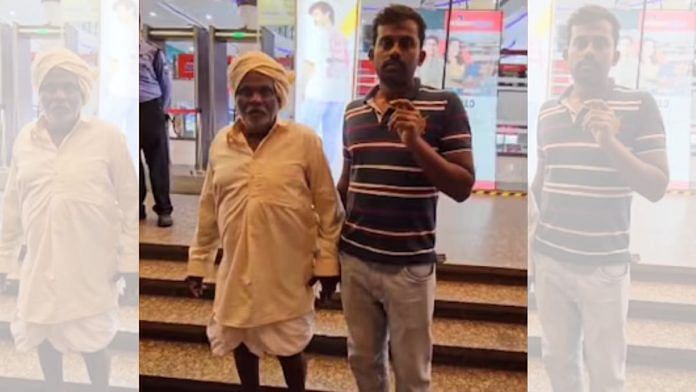All Fakeerappa wanted was to catch a movie with his son at Bengaluru’s GT World Mall. Even though he had a ticket, he wasn’t allowed to enter the building. The mall management, hungover on colonial sentiments, didn’t like the idea of a man roaming around their premises in a panche or dhoti.
Protests by some Kannada organisations followed, and the old farmer had to face multiple cameras, explaining to the media that while he is illiterate, he understands the value of education. It is embarrassing that the situation came to this. Fakeerappa wasn’t looking for media glare or attention, he travelled all the way from his village to the city for a multiplex experience.
I doubt the mall had explicitly stated rules that don’t allow people in panche to enter the mall. But it is a cocktail of Brahmanism and a colonial hangover that makes upper management decide who can and cannot enter a mall.
We should not reserve all our anger toward the security guard who stopped a man wearing a dhoti. The average city-dwelling Indian is no different than him in their perception of a dhoti-clad man. Scorn for the poor unites the ruling class of this country.
Also read: Mumbai colleges becoming Khap panchayats. How are students’ wardrobes any of your business?
Status symbols
Clothes and shoes are the biggest markers people use to judge others. Mobile phones and bags are a close second.
Everyone wants to look good, sure, but more importantly, everyone wants to look rich. They use their clothes and accessories to flash their social standing. It helps people control how they’re perceived in society.
Indian attire, especially menswear, is often looked down upon. Or at least not considered hip.
Women have redeemed sarees and suits. As actresses like Deepika Padukone and Alia Bhatt attend Met Gala and Cannes in jaw-dropping sarees, the garment has become timeless.
And in post-colonial times, women were expected to uphold tradition, while men were free to surrender them quickly and westernise. Jeans, pants, and skirts have long been associated with loose character; so it was society’s diktat that women wear traditional clothes. Men aren’t called slutty for wearing a double-breasted suit in harsh Indian summers.
But beware, wearing a saree without a blouse would still be scowled at. It’s what poor, tribal women wear.
Even the image of Prime Minister Narendra Modi consciously sporting kurta pyjamas and Nehru jackets at global events has not seemed to cement the idea that Indian wear is formal wear. Even in strict corporate settings, you’ll struggle to find a man in traditional Indian clothes. Women, on the other hand, flaunt their gorgeous sarees and kurta pyjamas regularly, mandated to wear them instead of Western formals in some cases.
Even in the realm of traditional clothes, a dhoti is placed below the kurta-pyjama. Known by various names—panche, dhoti, mundu, veshti—it’s largely associated with poverty in the popular imagination. Beyond the appearance on traditional festivals like Diwali, Holi or Onam, it hasn’t been given any place in modern elite spaces
It’s only natural then to conclude that it’s not dhoti that malls or guards in Namma Metro have a problem with. It is the poverty and class of the person wearing it.
Also read: India’s Olympics outfits are tacky. Tarun Tahiliani was too busy dressing Bollywood
Trapped in a narrative
In the post-capitalist world, our choices for consumption are largely drawn by sharp advertising and marketing techniques that affect us at a subconscious level.
Hideous bags, yes, I am calling them hideous, that have no uniqueness or quality beyond the name of the brand splashed all across them are sold for lakhs of rupees. It is the dream of the middle class to own them—it could elevate their social status.
No matter how hard we yell ‘make in India’ and write long Facebook posts about our nation’s pride, glory, and whatnot, at the end of the day we’re colonial stooges—wearing English clothes, speaking the English language and ordering coffee and croissants to our office and even reading this English article.
We’ve forgotten the minimalistic ideals of Gandhi. He would’ve been turned away from today’s glitzy malls too.
This subliminal marketing penetrates our thinking, our perception of other people, our needs, desires and goals. No mall security guard would ever dare to stop a woman in a stylish dhoti carrying a Gucci bag.
Dear reader, next time you look down on a dhoti-wearing man, remember that it is you who has been fooled by the fashion industry.
A Gucci bag’s value is nothing more than manufactured aspiration, and years of marketing. You’re trapped.
Anyone who wears a dhoti every day is free. Free of advertising narrative. Free of a colonial hangover. Free of a need to look a certain way.
Views are personal.
(Edited by Theres Sudeep)







here is no need to drag Brahmanism into this argument. While colonialism and Western ideology might be factors, associated with the tradition of wearing a dhotis. Not every problem in this country should lead to Brahmin-bashing.